EDITOR’S NOTE: Please be advised that this Nara travel guide hasn’t been updated in 2024. Prices and travel guidelines may no longer be accurate so it’s important that you verify any information before proceeding.
Many people who visit the Kansai region seem to focus on three cities – Osaka, Kyoto, and Nara. There are other interesting destinations within this area of western Japan though many itineraries seem to start with those three cities.
We had never been to Nara so we made a point to spend some time there on our most recent trip to the Kansai region. By most accounts, it didn’t seem to merit more than a day or two so we decided to visit on a day trip from Osaka.
If you’re unfamiliar with Nara, it isn’t a booming metropolis like Tokyo or Osaka. It’s traditional in feel, more closely resembling Kyoto with its wealth of historical and cultural attractions. I like to think of it as “Kyoto light”, with deer.
If you’re traveling to the Kansai region and looking to spend time in Nara, then I hope this day tripper’s travel guide can help you plan your trip.
VISIT NARA QUICK LINKS
This travel guide to Nara is long. For your convenience, I’ve compiled links to hotels, tours, and other services here.
HOTELS
This is a day-tripper’s guide but people staying the night may be interested in one of these top-rated hotels in Nara.
- Luxury: Piazza Hotel Nara
- Midrange: Nara Royal Hotel
- Budget: OYO Hotel Base Nara
SIGHTSEEING TOURS
- From Nara: Nara Like a Local: Customized Guided Tour
- From Kyoto: Nara Half Day Bus Tour from Kyoto
- From Osaka: Nara Day Tour with Local Guide from Osaka
OTHER SERVICES
- Visa Services
- Travel Insurance with COVID cover (WFFF readers get 5% off)
- Kansai Thru Pass
- Japan Rail Pass
- Japan eSIM
Save This on Pinterest!
No time to read this Nara travel guide now? Click on the save button and pin it for later!
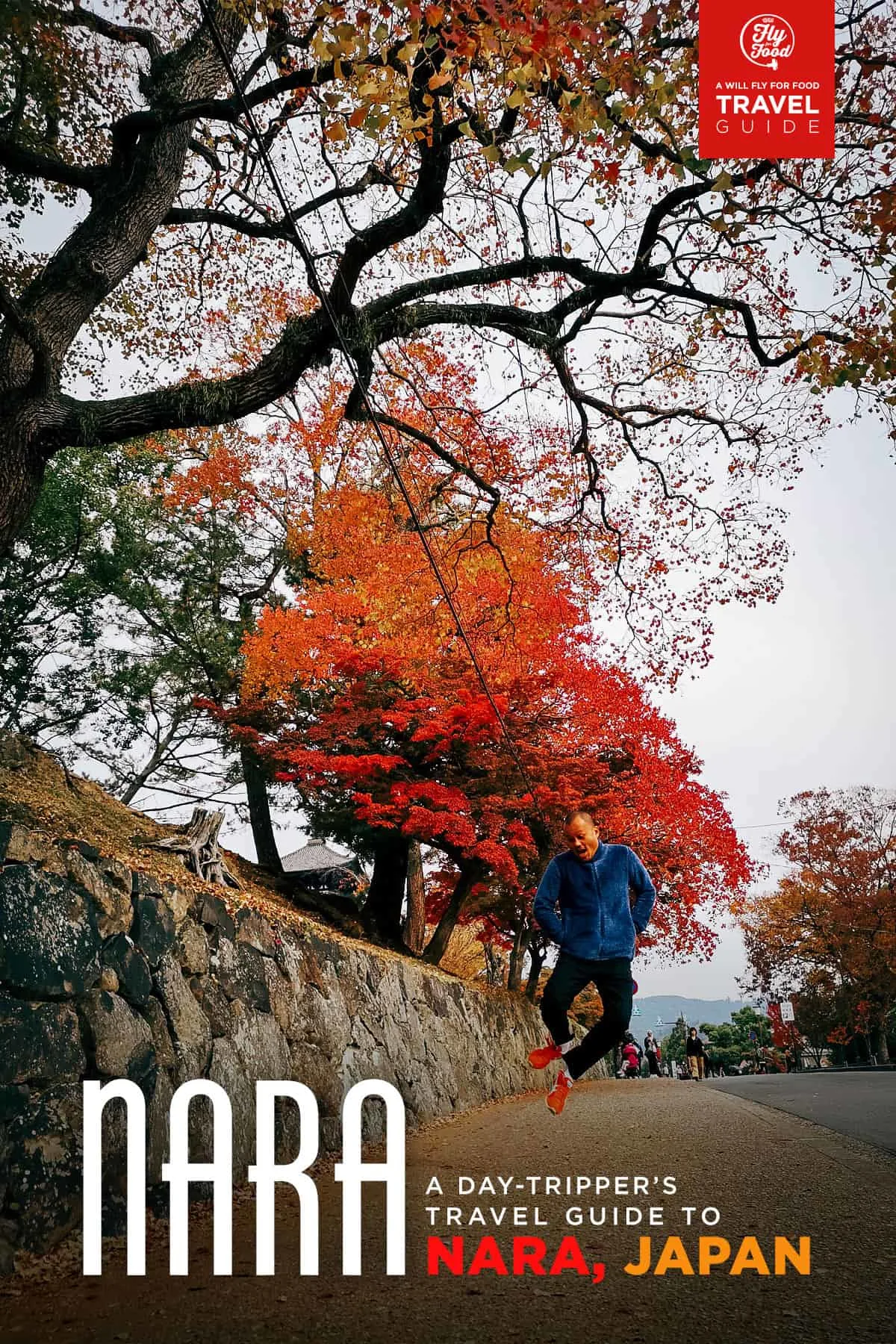
GUIDE TABLE OF CONTENTS
NARA TRAVEL RESTRICTIONS
Because of the current global situation, Nara travel guidelines change very frequently. Our friends at Booking.com created a website that lists detailed information on travel restrictions around the globe.
Before planning a trip to Nara, be sure to check Booking.com for information on travel restrictions to Japan. If you do decide to visit Nara, then you may want to seriously consider getting travel insurance with COVID coverage.
JAPAN VISA
Depending on your passport, you may need a visa and other requirements to travel to Japan. Visit iVisa.com to learn about the requirements and to apply for a visa (if necessary).
NARA AT A GLANCE
When people think of Nara today, they usually think of deer. But what many people probably don’t know, is that Nara holds the distinction of being Japan’s first permanent capital. Formerly known as Heijō, Nara became the country’s seat of government in the year 710. It held that title till 784, before the capital was moved to Nagaoka then Kyoto where it stood for the next thousand plus years.
Because it was Japan’s first permanent capital, Nara remains a culturally rich and historically significant city, second only to Kyoto in its wealth of traditional temples and shrines. There you’ll find eight historical attractions that make up the UNESCO World Heritage Site known as the Historic Monuments of Ancient Nara.
The site is comprised of 26 buildings designated as National Treasures, at the core of which is Tōdai-ji Temple, a proud landmark of Nara that’s revered as one of Japan’s most historically significant temples.
BEST TIME TO VISIT NARA
Like Osaka and Kyoto, the best times to visit Nara are in Spring (Mar-May) and Autumn (Sept-Nov). The weather is temperate and the landscape is at its most beautiful, characterized by the pinks of cherry blossom season and the fiery oranges and reds of autumn.
DEC-FEB: This is winter in Nara. Temperatures can go as low as -0.2°C (31.6°F) so it’s probably not the best time to go if you don’t like cold weather.
MAR-MAY: Spring is one of the best and most popular times to visit Nara. Cherry blossom season typically begins around the end of March, with flowers being in full bloom by the first week of April. It’s one of the most beautiful times of the year in Nara so expect heavier crowds.
JUN-AUG: This is summer in Nara. It tends to get hot and humid – reaching a high of 32.6°C (90.7°F) in August – so this isn’t the most comfortable time to go. June and July are also the rainiest months of the year.
SEPT-NOV: Autumn is a terrific time to visit Nara. Like spring, the weather is mild and the landscape is at its most picturesque. We were there in late November and the leaves turn to striking hues or red, orange, and yellow. It’s the perfect backdrop for your Instagram #ootd!
Climate: Annual Monthly Weather in Nara
To help you better understand the weather in Nara, I’ve included average temperature and annual rainfall graphs below. Suggested months to visit are indicated in orange.
Average Temperature
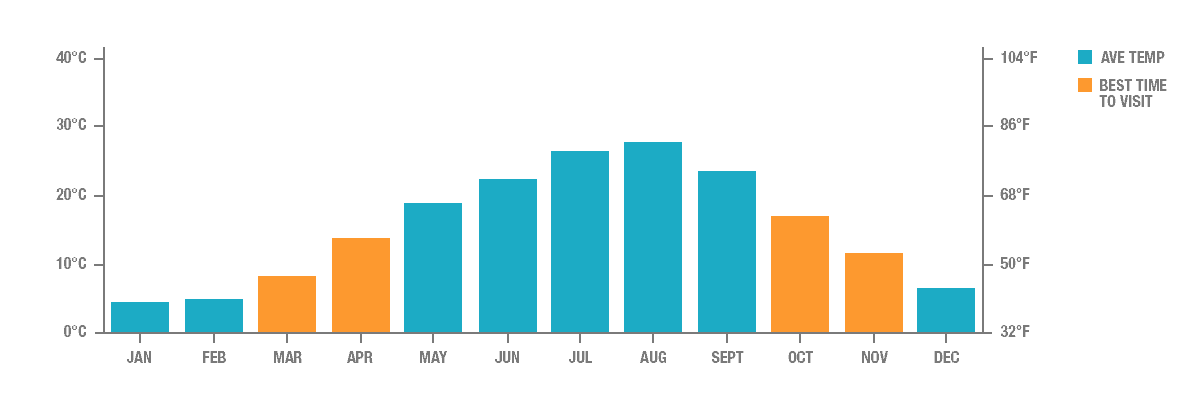
Annual Rainfall
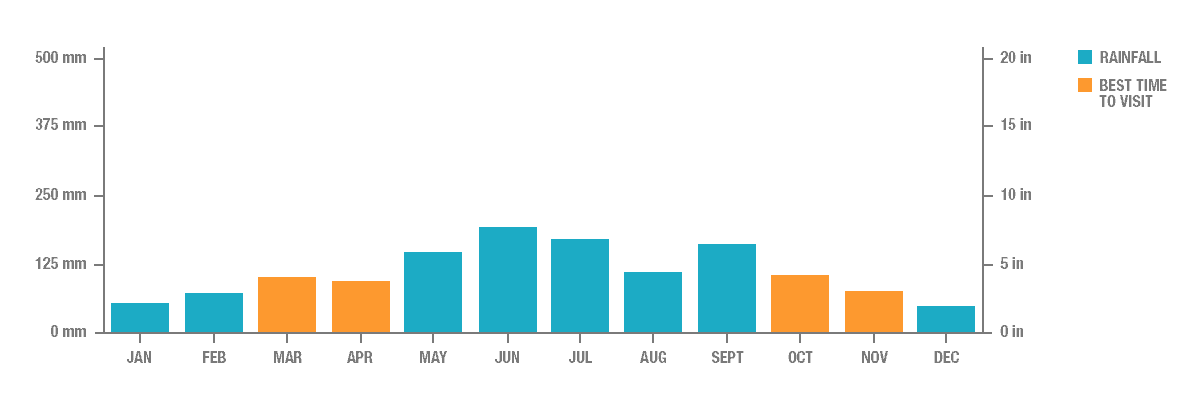
NARA BY GUIDED TOUR
Japan’s railway system is highly efficient so it’s easy to visit Nara on your own. However, some people may prefer to go on an organized tour with a guide. It’s an added cost so we rarely go on tours unless we feel it’s absolutely necessary. We didn’t go on one in Nara but if you want the benefit of a guide explaining everything to you, then it may be a good idea.
If you’re interested in going on a guided tour in Nara, then you can check out these tours from Klook, Get Your Guide, and Magical Trip. There are a few tour variations to choose from starting from Nara, Osaka, or Kyoto.
If you’re interested in going on a guided tour in Nara, then you can check out these tours from Klook, Get Your Guide, and Magical Trip. There are a few tour variations to choose from starting from Nara, Osaka, or Kyoto.
FROM NARA: GYG | Magical Trip
TRAVELING TO NARA
By train is the best and easiest way to get to Nara from wherever you are. It’s cheap, fast, and very efficient. Just plot your trip using hyperdia.com and you’ll be fine.
Another option is to go by private car charter. It’ll be a lot more expensive but if you’re traveling in a larger group and want the flexibility and comfort of a chauffeured car, then it may be worth looking into. Check out this Kyoto and Nara private car charter from Klook for more information.
But as advised, if you’re a commoner like us (ha!) and want the most practical option, then going by train is best. You can get a single journey ticket or invest in one of Japan’s many transportation passes. This may be a worthwhile investment if you’ll be traveling extensively in the Kansai region or throughout Japan. Choosing the right pass can be daunting so I’ve narrowed it down to make it less confusing.
Kansai Thru Pass
If you plan on exploring multiple cities within the Kansai region, then a Kansai Thru Pass may be a good investment. Available in 2- or 3-day variants, it’ll give you unlimited train and bus rides within the region so you can commute between Kansai cities like Osaka, Kyoto, Nara, Kobe, etc as often as you like.
Unfortunately, it isn’t valid for travel on JR trains, but unlike JR Passes, you don’t have to use it on consecutive days. You can even use it to go from Kansai International Airport (KIX) to your hotel in the Kansai region, provided you ride only on non-JR trains. You can purchase the Kansai Thru Pass on Klook.
JR Kansai Area Pass
Like the Kansai Thru Pass, the JR Kansai Area Pass gives you unlimited travel within the Kansai area. The main difference is that the JR Kansai Area Pass is for use on JR trains (including the Kansai Airport Express Haruka) and needs to be used on consecutive days. You can purchase the JR Kansai Area Pass on Klook.
ICOCA IC Card
The ICOCA IC Card isn’t an unlimited use pass like the previous two. Instead, it’ll give you discounts on JR trains (including the Kansai Airport Express Haruka), the subway, private railways, and buses. It’s rechargeable so you can think of it as a stored value card similar to Hong Kong’s Octopus Card. It’ll save you from the hassle of having to buy single journey tickets every time.
JR Pass
If you’ll be exploring many cities throughout Japan, then a JR Pass may be the most appropriate for you. It’ll give you unlimited rides on all JR national trains in Japan – including Shinkansen bullet trains, the Kansai Airport Express Haruka, and the Narita Express – for a consecutive number of days. JR Passes are available in 7-, 14-, or 21-day variants which you can purchase through Klook or Japan Rail Pass.
WHERE TO EXCHANGE CURRENCY
The unit of currency in Japan is the Japanese Yen (JPY).
This guide assumes that you’ll be visiting Nara on a day trip from Kyoto, Osaka, or some other nearby city. If that’s the case, then you should already have Japanese Yen (JPY) with you. If not, then the best place to exchange currency in Japan is at banks and post offices.
Another option is to withdraw JPY from an ATM. The rates are competitive. Just be sure to let your bank know that you’ll be using your ATM card in Japan so you don’t run into any problems. In my experience, my ATM card works fine in some machines but not in others.
NOTE: Some ATMs may ask you if you’d like to proceed “with or without conversion”. NEVER proceed “with conversion” because doing so authorizes the foreign bank operating the ATM to do the conversion instead of your local bank. The rates are usually terrible, the difference in rates often being as high as 10%.
ATTRACTIONS TO VISIT IN NARA
As described, Nara is second only to Kyoto in its number of traditional temples and shrines. There’s a lot to see here. However, this guide assumes that you’ll be visiting on a day trip which isn’t enough time to see everything. As such, I’ve narrowed it down to some of the most important attractions, all of which are conveniently located in Nara-koen which is the main park area.
1. Tōdai-ji Temple
Todai-ji Temple is one of eight sites that comprise the Historic Monuments of Ancient Nara. It’s without a doubt the most important attraction in this city. As some people have described, it isn’t just a must-see in Nara, it’s a must-see in all of Japan.
Constructed in the year 752, it was the head temple of all provincial Buddhist temples and the main reason why the capital was moved to Nagaoka in 784. It grew so powerful that the capital was moved away from Nara to lower the temple’s influence on government affairs. If you had time to visit just one attraction in Nara, then this should be it.
Tōdai-ji is comprised of multiple structures, many of which will take up a good chunk of your time. Pictured below is Nandaimon Gate, the main entrance to the temple and one of the 26 aforementioned national treasures in Nara. This is a good place to feed the deer. Near the gate you’ll find vendors selling shika senbei or deer crackers, as well as multiple food stands offering different types of Japanese street food and snacks.
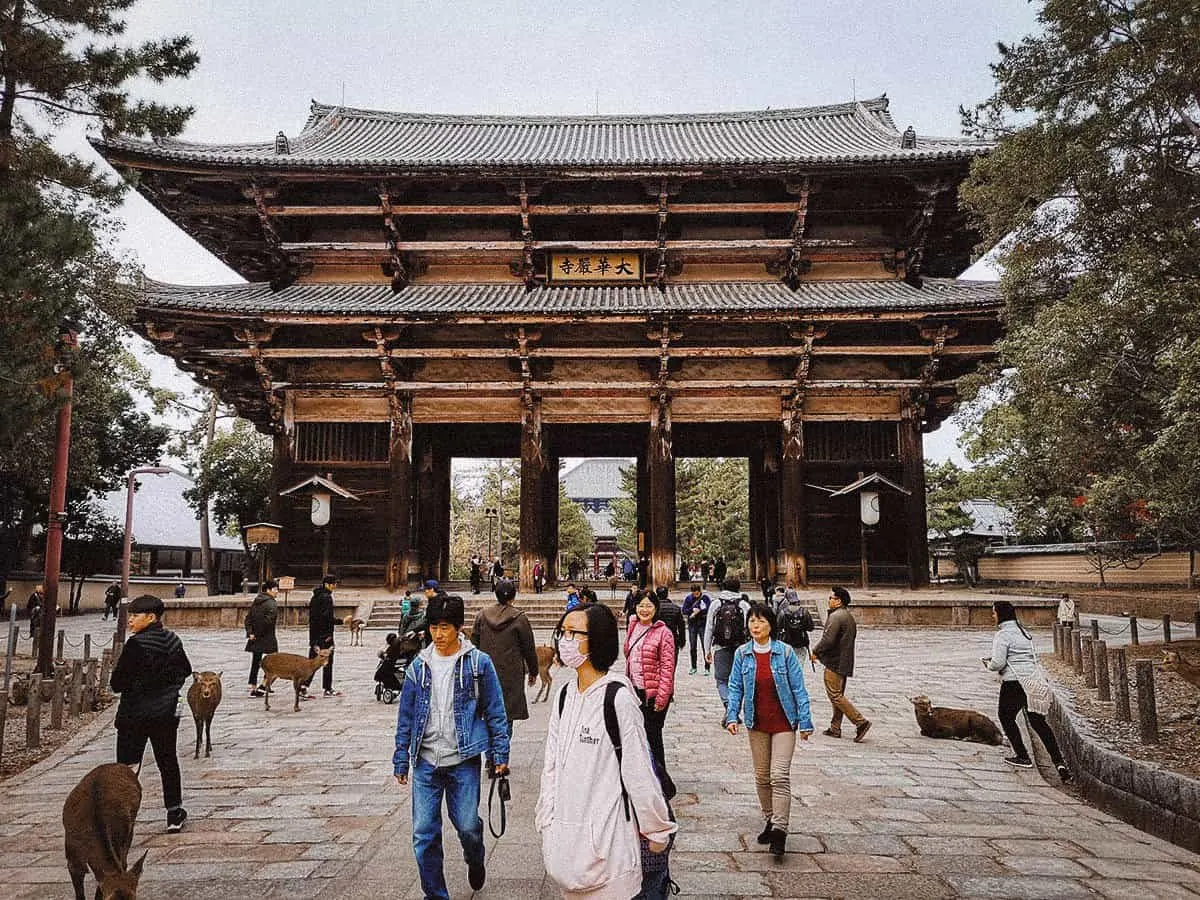
This is the heart and soul of Todai-ji. The Daibutsuden or Big Buddha Hall is the largest wooden structure in the world and houses one of Japan’s biggest bronze statues of Buddha. Like Nandaimon Gate, it’s one of the 26 designated national treasures in Nara.
Aside from the Daibatsuden, there are several other structures in Todai-ji that are worth visiting. You can refer to this article on Todai-ji Temple for more information. Some of the most important include Nigatsu-do Hall, Hokke-do Hall, and Todai-ji Museum.
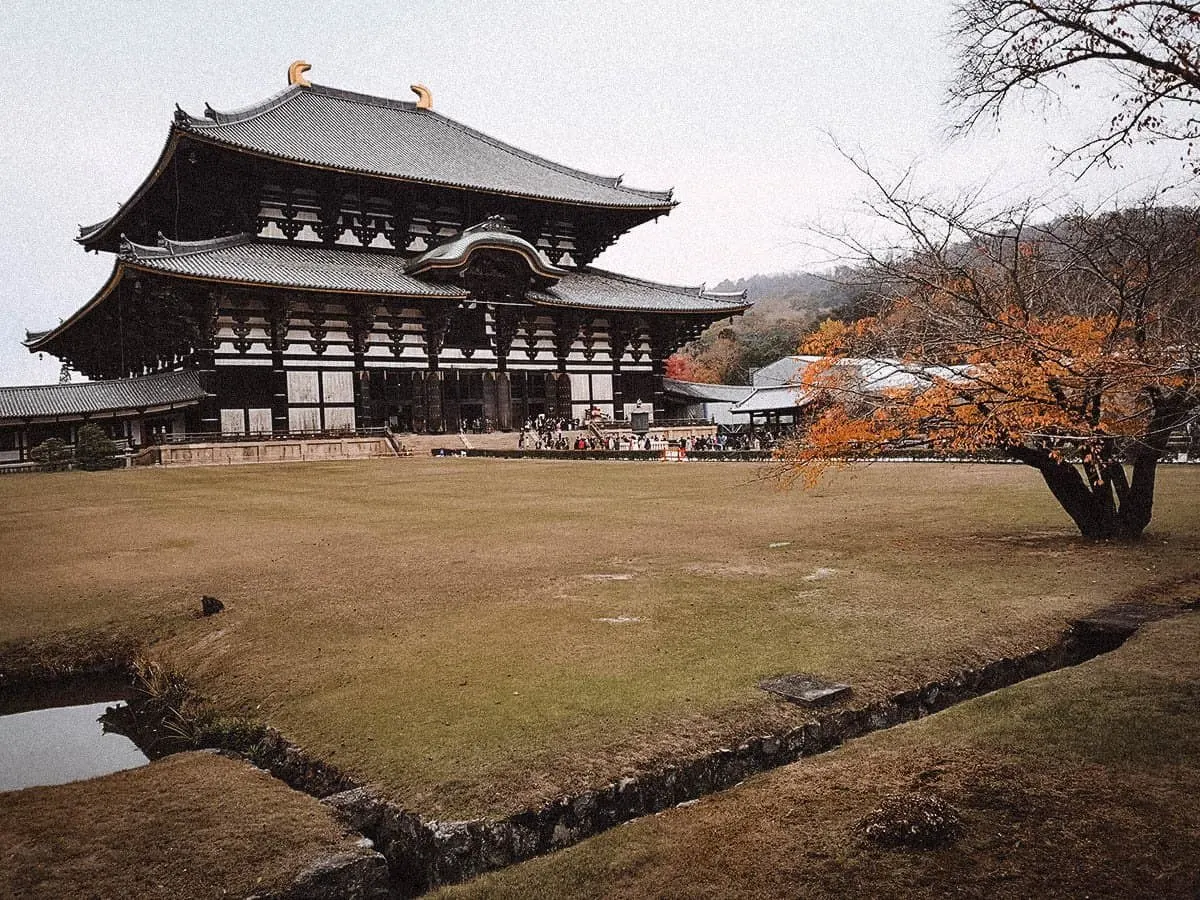
Approximate time needed: About 2-3 hours
Admission: JPY 600
2. Kasuga-taisha Shrine
Like Todai-ji, Kasuga-taisha is one of eight sites that make up the Historic Monuments of Ancient Nara. It’s the only shrine on the list and perhaps holds the key as to why deer have become synonymous with this city. According to the shrine’s history, the god Takemikazuchi arrived on a white deer to guard Nara (then known as Heijō), leading to the belief that deer are heavenly animals sent to protect the city and the rest of the country.
I visited Kasuga-taisha shortly after sundown so I didn’t have much time to go through it. It’s comprised of multiple buildings set in a more heavily wooded area of the park. The buildings are interesting but what I enjoyed most are the shrine’s grounds. You can walk on pathways through the woods around Kasuga-taisha, along which you’ll find several smaller auxiliary shrines. It’s a mysterious place that would have been fun to explore with more time.
Walking around Kasuga-taisha, you’ll find hundreds of these bronze and stone lanterns hanging from buildings and along pathways. Kasuga-taisha is famous for its lanterns which are lit twice a year during lantern festivals in early February and mid-August.
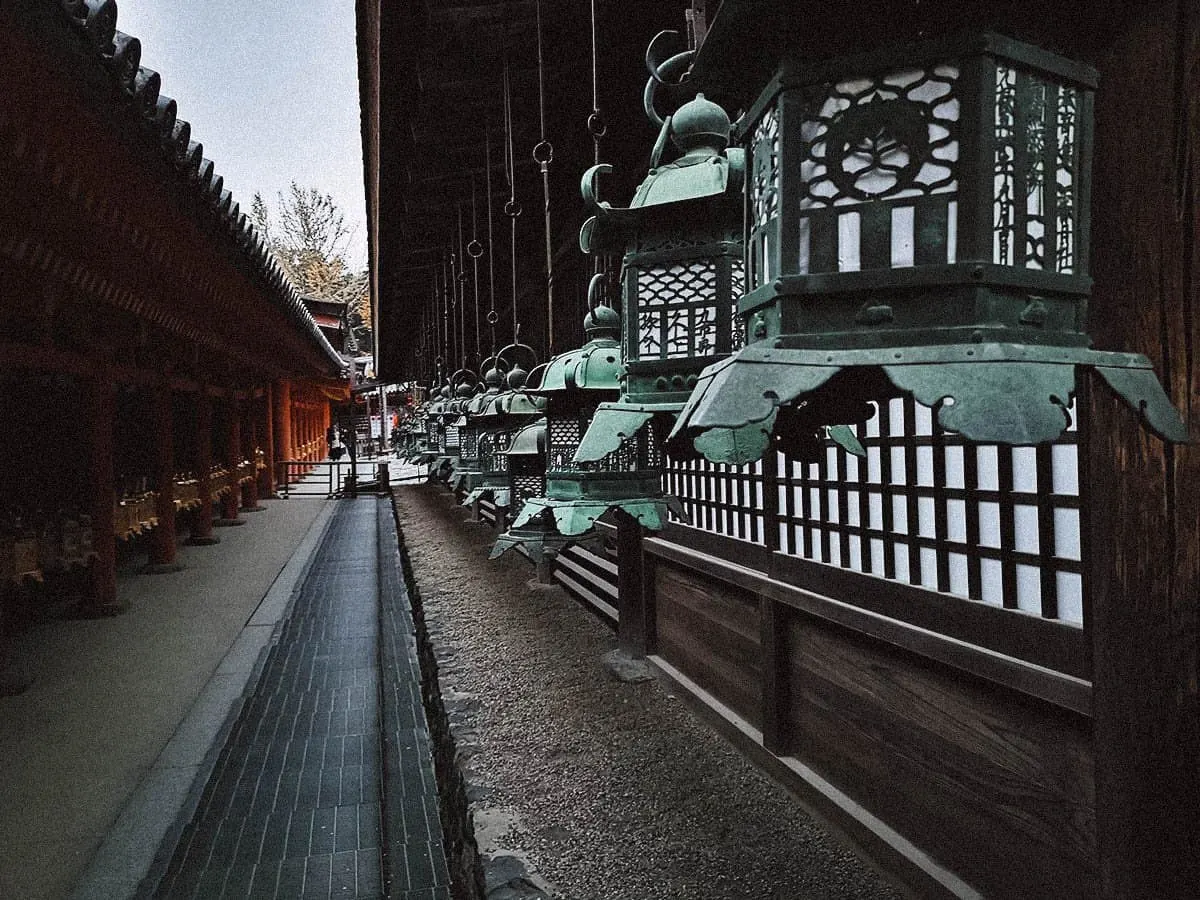
Approximate time needed: About 1.5-2 hours
Admission: Free (outer area), JPY 500 (inner area)
3. Kofuku-ji Temple
Like Todai-ji and Kasuga-taisha, Kokufu-ji Temple is among the eight sites that comprise the Historic Monuments of Ancient Nara. It’s comprised of multiple buildings including a 50-meter 5-storied pagoda that’s the second tallest in Japan.
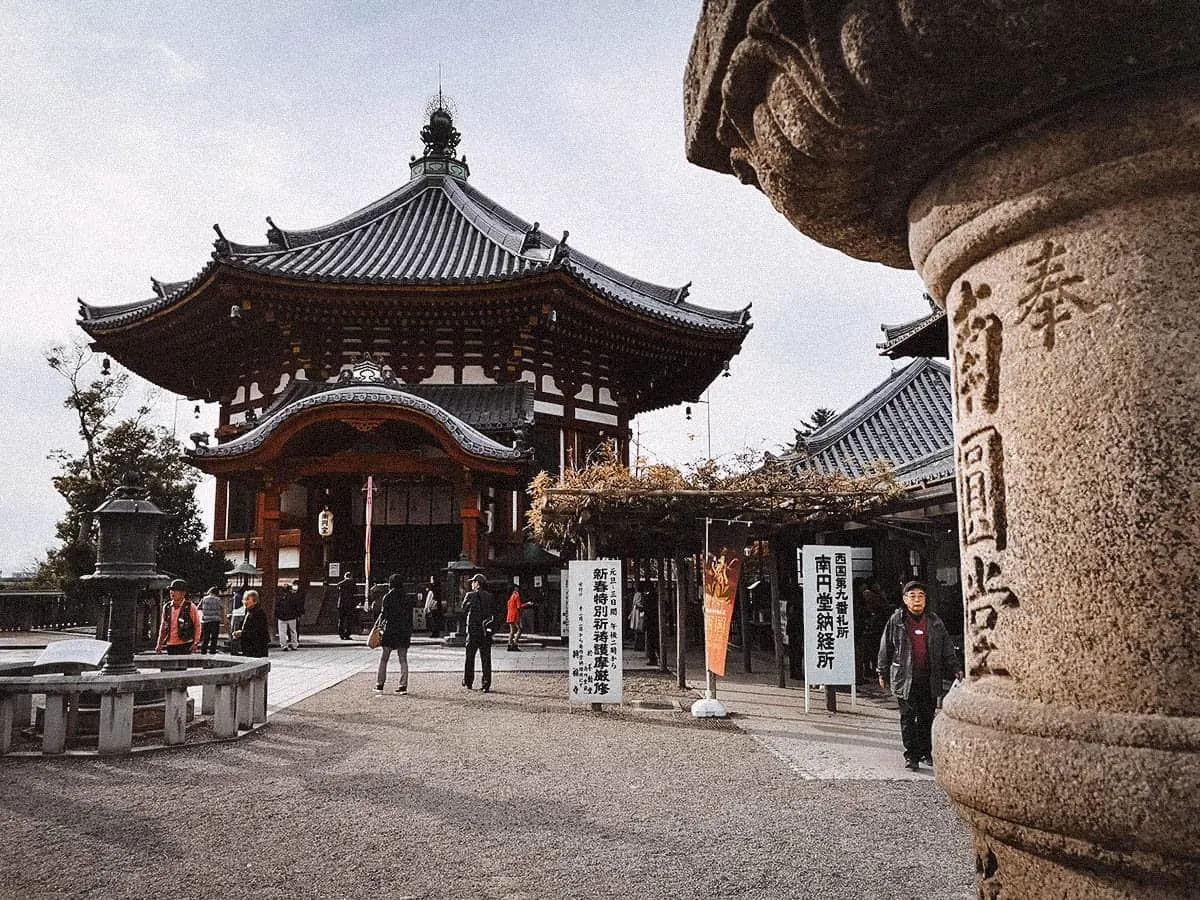
Pictured below is Kofuku-ji’s 5-storied pagoda. It’s second in height only to the 5-storied pagoda at Kyoto’s Toji Temple. Walking around the Kofuku-ji Temple grounds is free but you’ll need to pay admission fees to enter three of its main buildings. Details below.
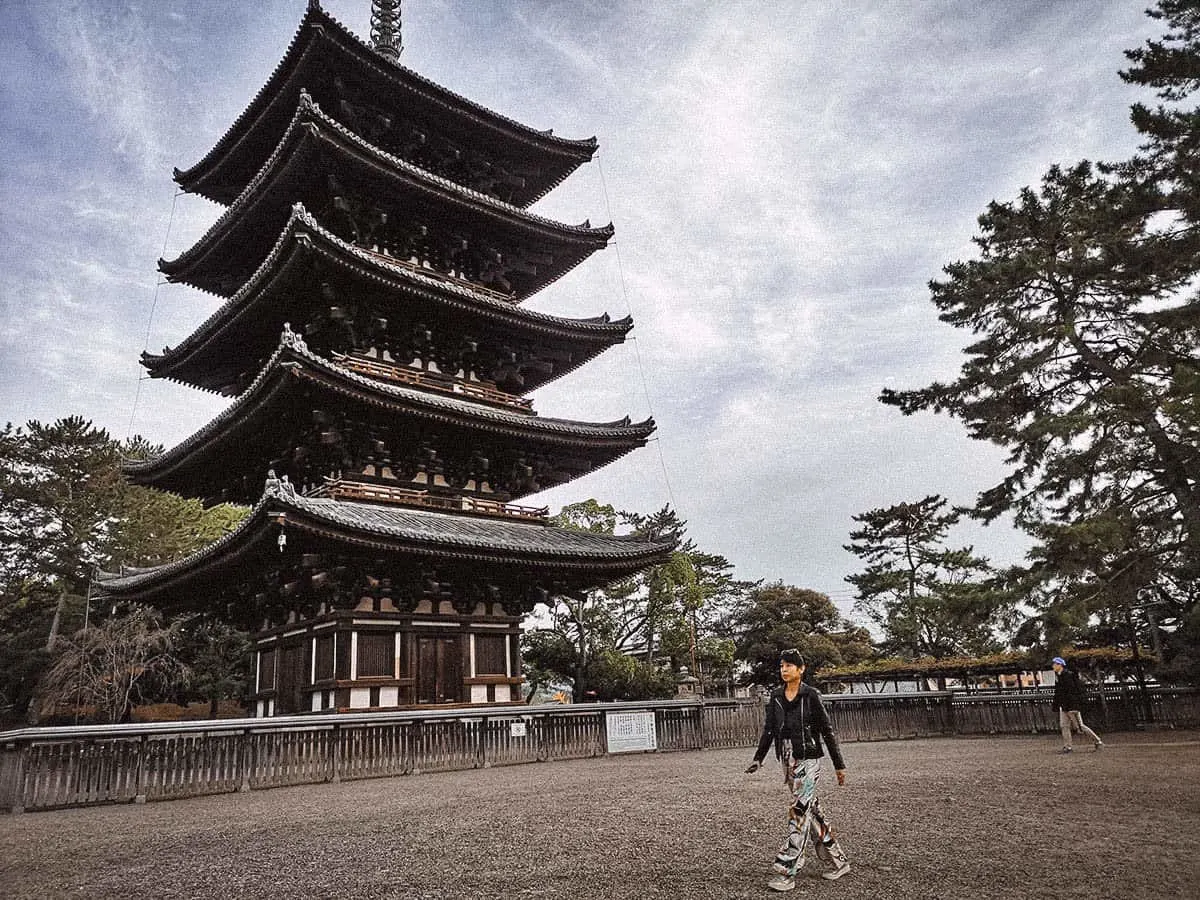
Approximate time needed: About 1.5-2 hours
Admission: JPY 700 (National Treasure Hall), JPY 300 (Eastern Golden Hall), JPY 500 (Central Golden Hall), JPY 900 (National Treasure Hall and Eastern Golden Hall combined ticket)
4. Isui-en Garden
If you like Japanese gardens, then you need to visit Isui-en Garden. It’s been described as the most beautiful garden in Nara.
Comprised of a front and rear garden, there are teahouses throughout Isui-en where you can enjoy a hot cup of matcha whilst taking in the view.
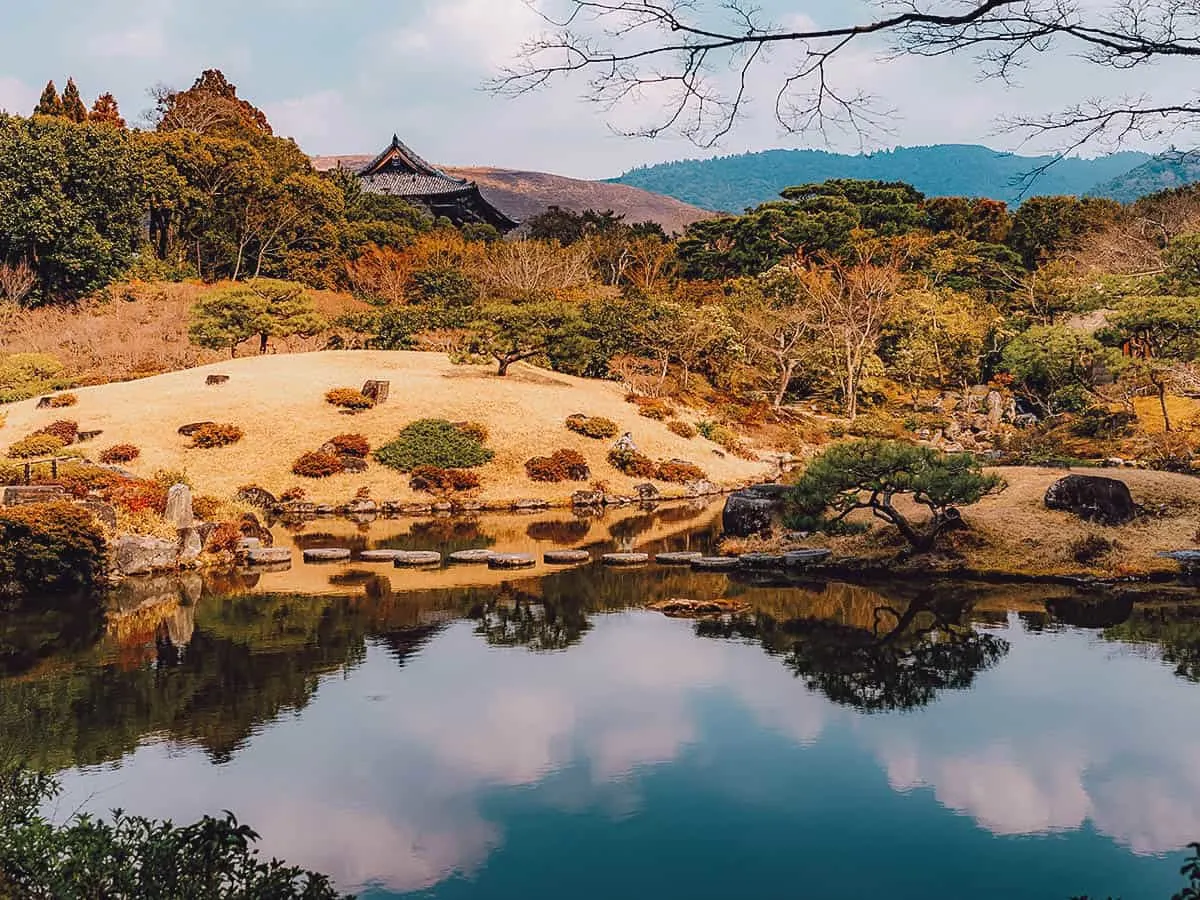
Photo by Dan Tiego via Shutterstock
Approximate time needed: About 1-1.5 hours
Admission: JPY 1,200
5. Tamukeyama Hachiman Shrine
This is a smaller, lesser known shrine dedicated to Hachiman, the god of warriors. Located between Todai-ji and Mt. Wakakusayama, I made a quick stop here en route to Kasuga-taisha.
Tamukeyama Hachiman Shrine isn’t as interesting as the others but admission is free so it may be worth visiting if you have the time. There are fewer people here, making it a nice quiet place to stop and enjoy Nara’s atmosphere between visits to the more popular attractions.
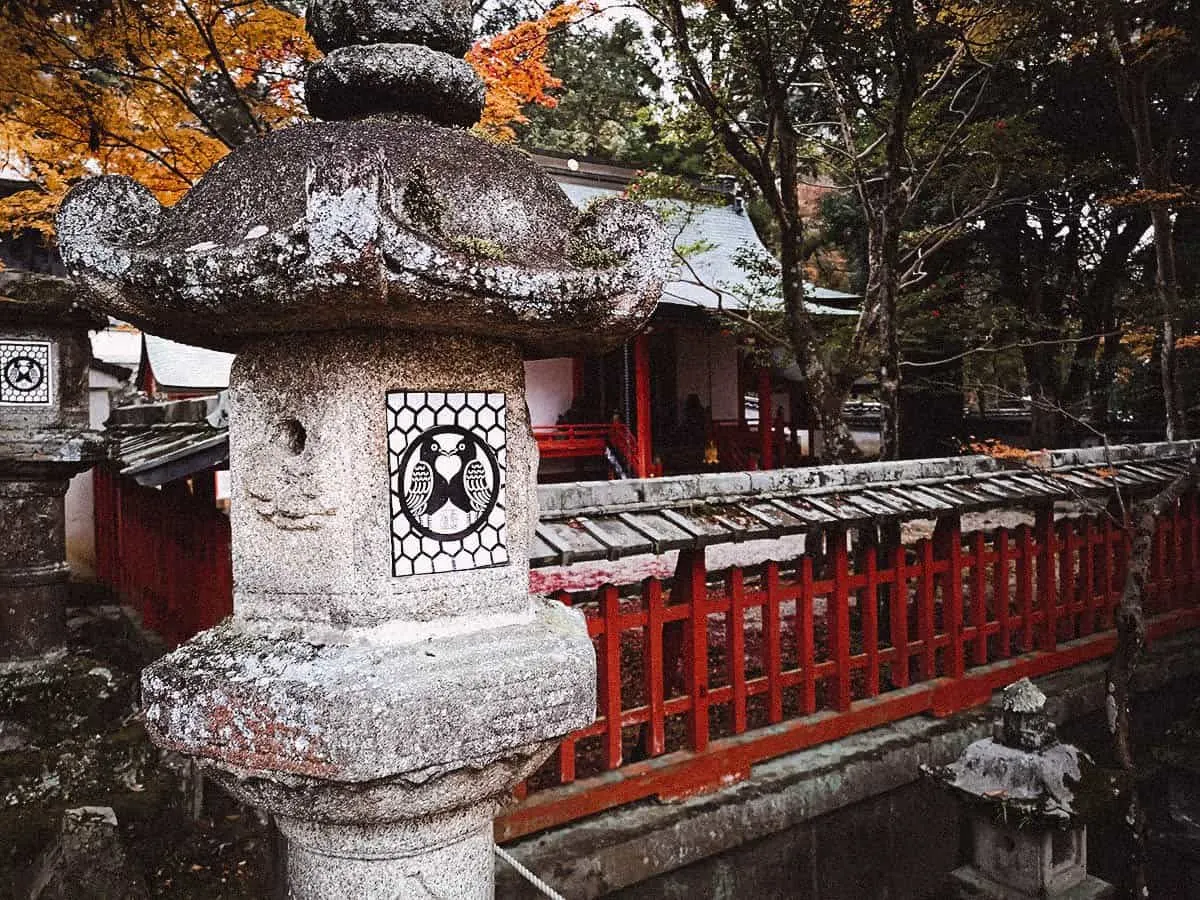
Approximate time needed: About 30 mins – 1 hour
Admission: FREE
6. Nara National Museum
People with an interest in Buddhism may want to check out the exhibits at Nara National Museum. It’s comprised of two buildings – one containing the museum’s permanent collection of Buddhist images, and another holding its temporary exhibits.
You can check out the Nara National Museum website for more information.
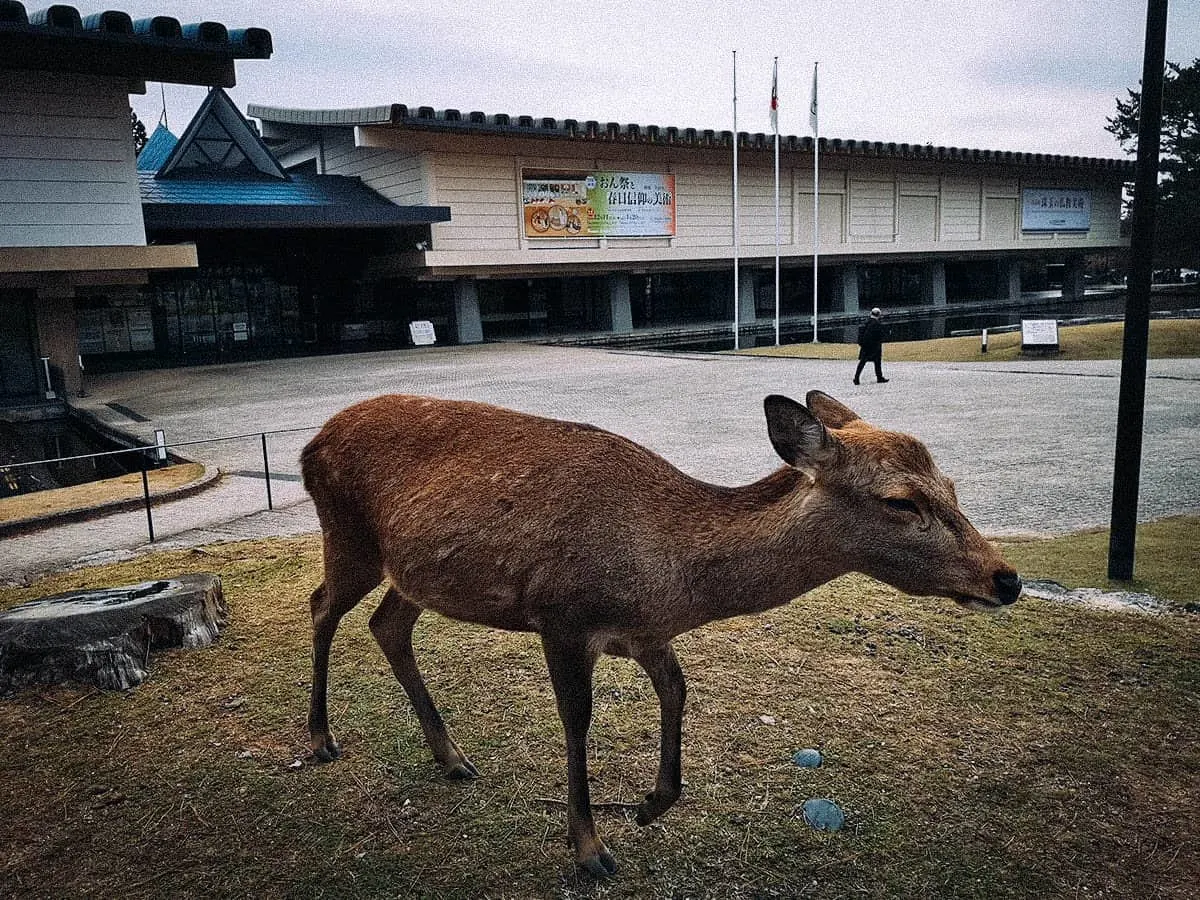
Approximate time needed: About 2-3 hours
Admission: JPY 700
THINGS TO DO IN NARA
1. Feed the Sika Deer
This is perhaps the number one reason why many foreigners come to Nara, to feed the sika deer. As described, they’re viewed as guardians of the city so they’re treated with reverence and respect. I’ve read that many will even return your bow for a deer cracker, known locally as shika sembei.
You can find deer throughout the park so just look for vendors selling shika sembei. Each bundle goes for JPY 150. We found a few around Todai-ji’s Nandaimon Gate.
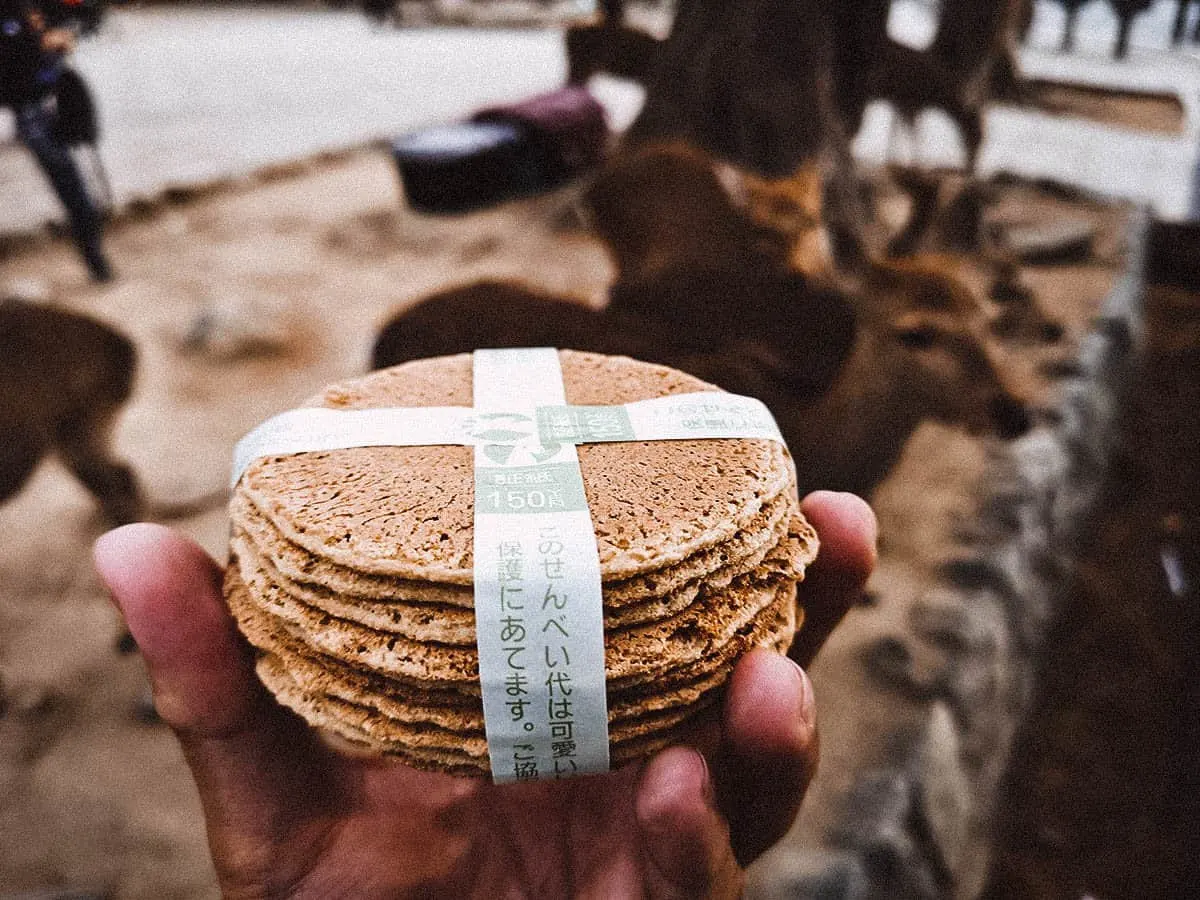
After watching Bambi, you’d think that all deer are cute and docile but that isn’t the case. These sika deer can be very aggressive when they see you carrying food. They will actively try to bite it out of your hand, even chew on your clothing to get you to give it to them. Be careful when feeding the deer and never give crackers to small children.
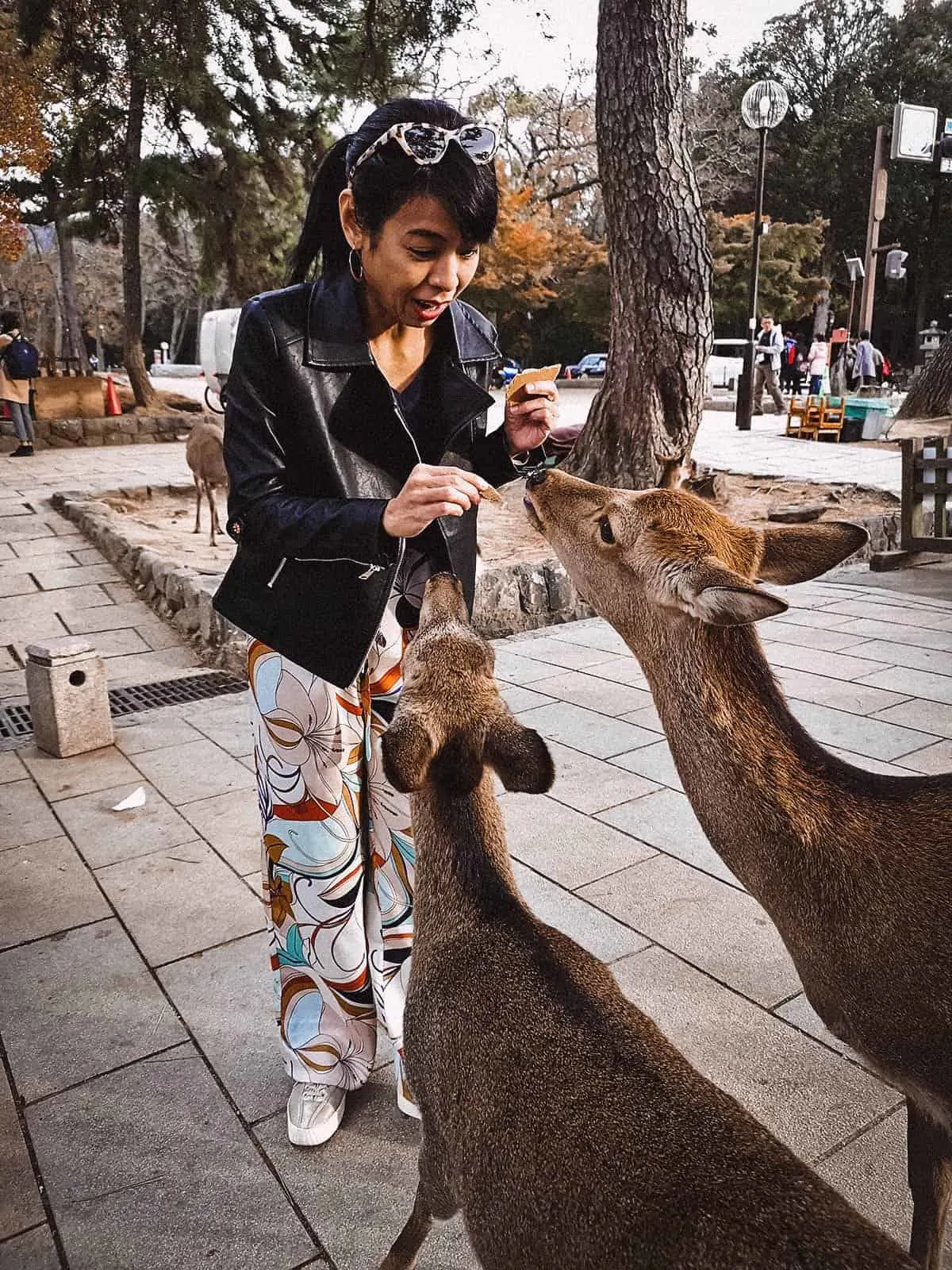
2. Rent a Kimono
I know, renting a kimono in Japan sounds like a cliche, but I don’t care. It’s fun and makes for great pictures, especially when you’re in the right environment. Because of its wealth of traditional temples and shrines, Nara is one of the best places to rent a kimono in the Kansai region. We rented one in Kyoto and came away with some great photos.
You can find a kimono rental shop in Nara but if you’d like to arrange for one in advance, then you can do so through Klook. This may be a good idea during peak times like cherry blossom season because shops have been known to run out of kimonos. Klook offers kimono rental packages with one-way transfers from Kyoto to Nara, so you may want to go with that if you’re staying in Kyoto.
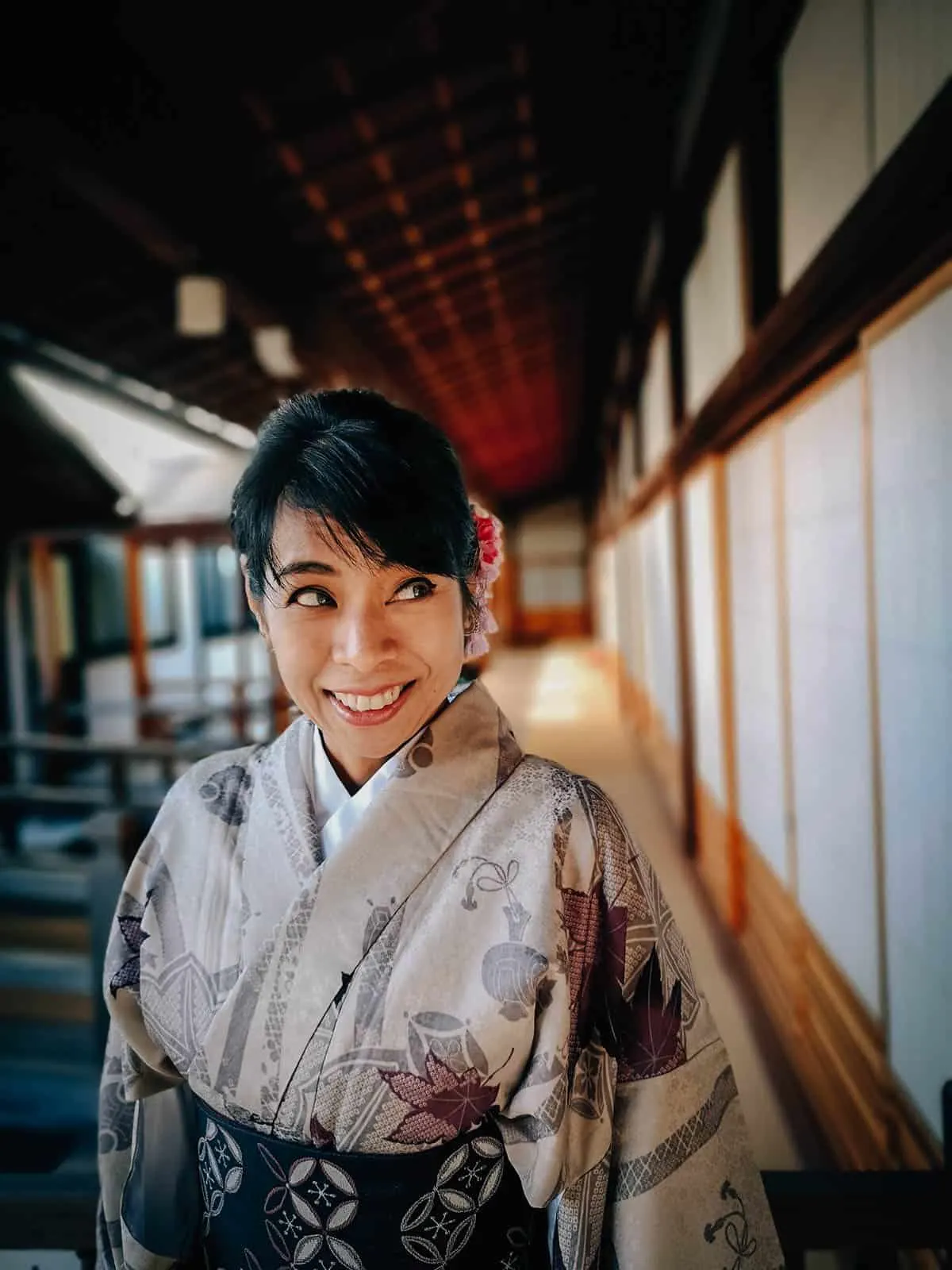
3. Experience a Traditional Tea Ceremony
Enjoying a traditional tea ceremony is one of the most memorable cultural experiences you can have in Japan. It involves the ceremonial preparation and serving of matcha (green tea), often with traditional Japanese confections known as wagashi. It’s a tradition that dates all the way back to 13th century Japan.
If you’d like to experience a traditional Japanese tea ceremony on your visit to Nara, then you can arrange one through byFood.
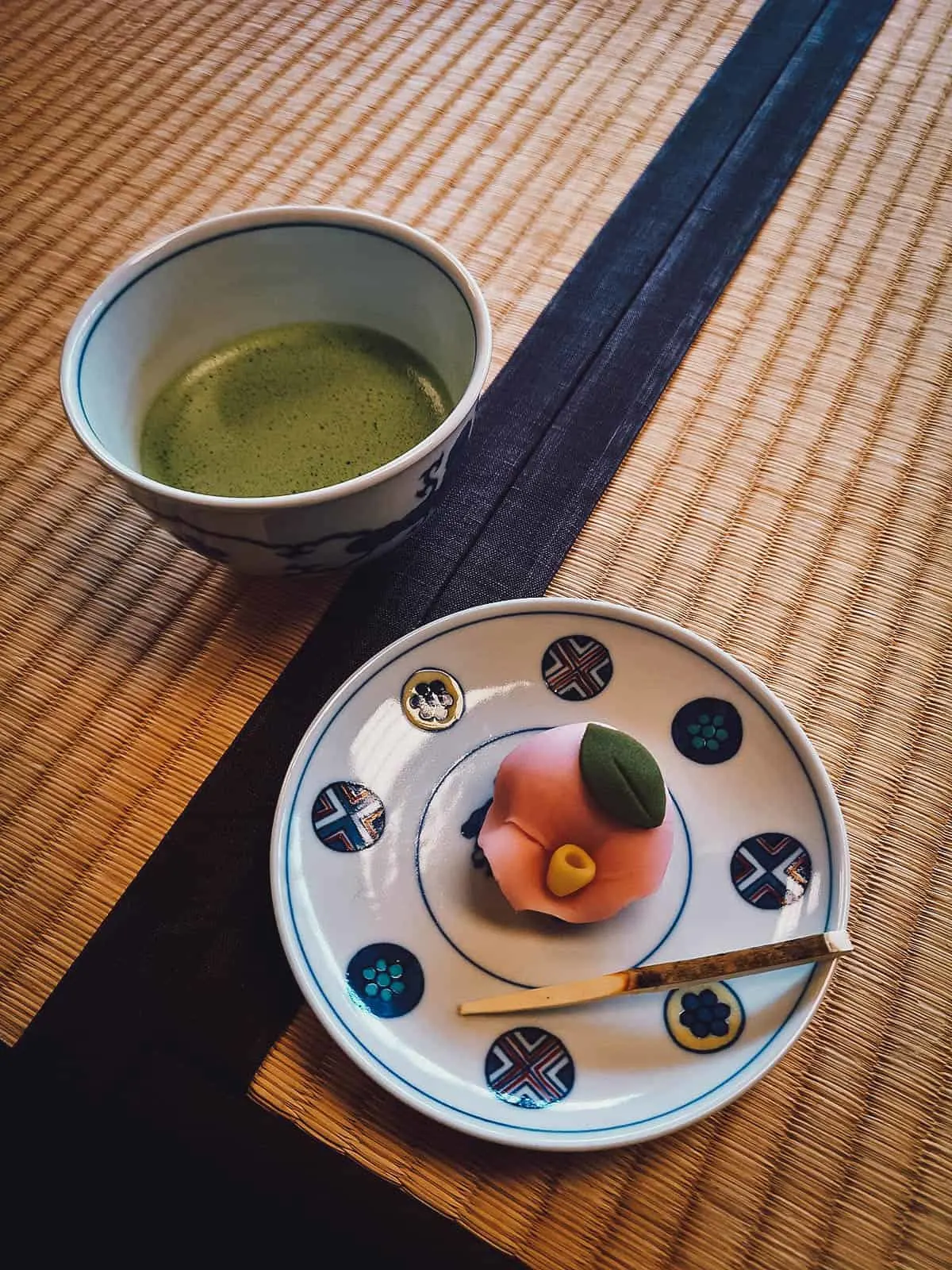
JAPANESE FOOD GUIDE
Japanese is my absolute favorite cuisine in the world. I can’t get enough of it which is a big reason why we try to visit this country at least once a year. If you enjoy Japanese food as much as we do, then you might want to read our article on the best dishes to eat in Japan. It features popular dishes in Japan as well as regional specialties by prefecture.
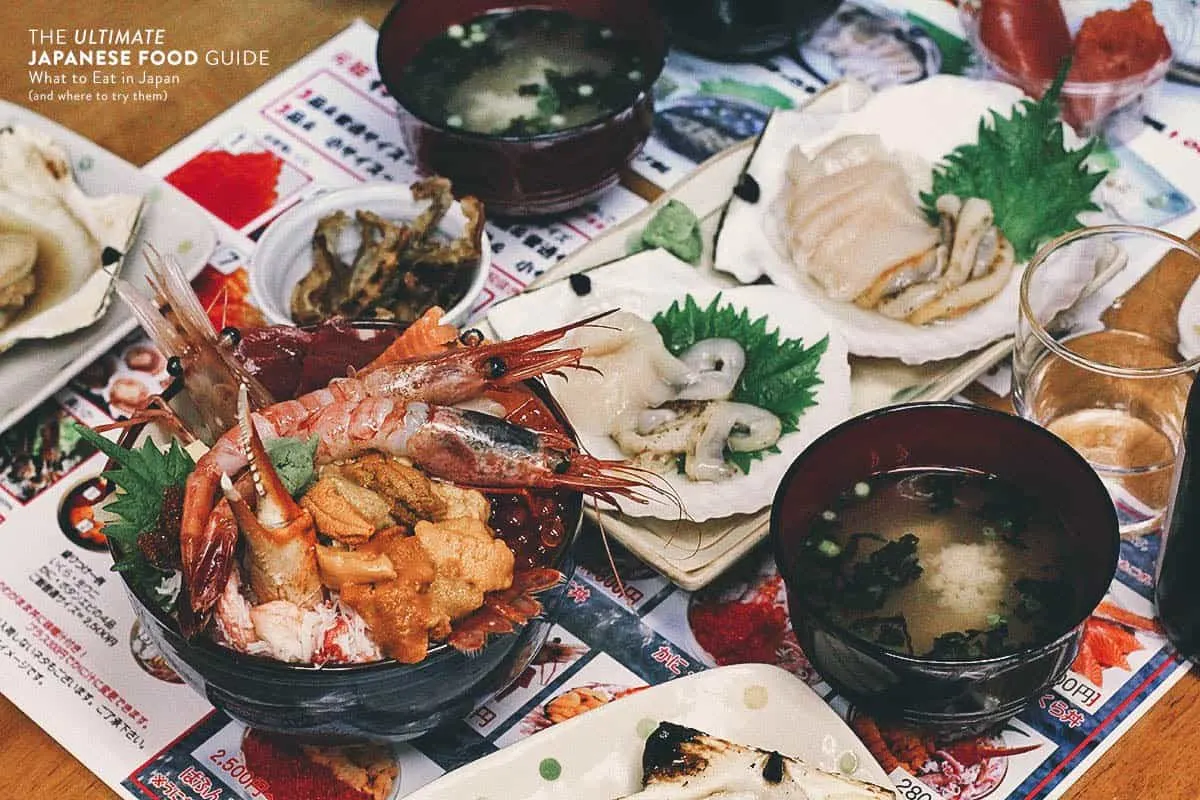
WHERE TO EAT IN NARA
1. Nakatanidou
I had read about this famous mochi place in Nara called Nakatanidou so I added it to our itinerary. What I didn’t know, is that it’s the very place that was featured by Great Big Story. They crowned it’s owner – Mitsuo Nakatani – as the fastest mochi maker in Japan, and we got to see him in action without expecting it. Click on the link to watch him slap that mochi to submission. So cool!
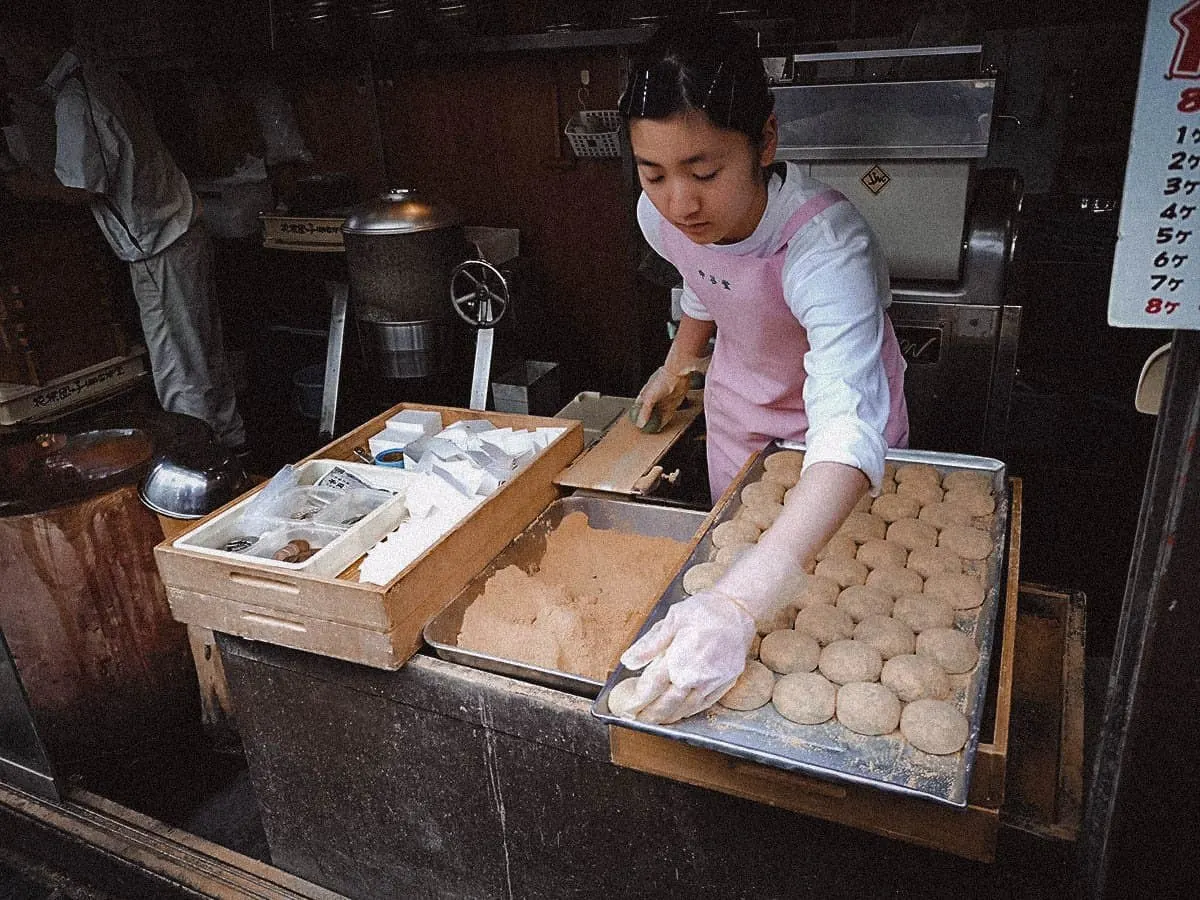
Nakatanidou specializes in kusa mochi, a type of red-bean-filled mochi made from the leaves of the yomogi or Japanese mugwort plant. Like many Asians, we’ve had mochi countless times before but this was easily one of the best we’ve ever had. As you can see in the picture below, it was ridiculously soft and chewy. It was so good that our Japanese friend Tsutomu immediately bought another pack to bring home to his wife.
If you like mochi, then you HAVE to try this. And if you’re lucky, then you may just catch Mitsuo Nakatani and his lightning fast mochi-making hands in action.
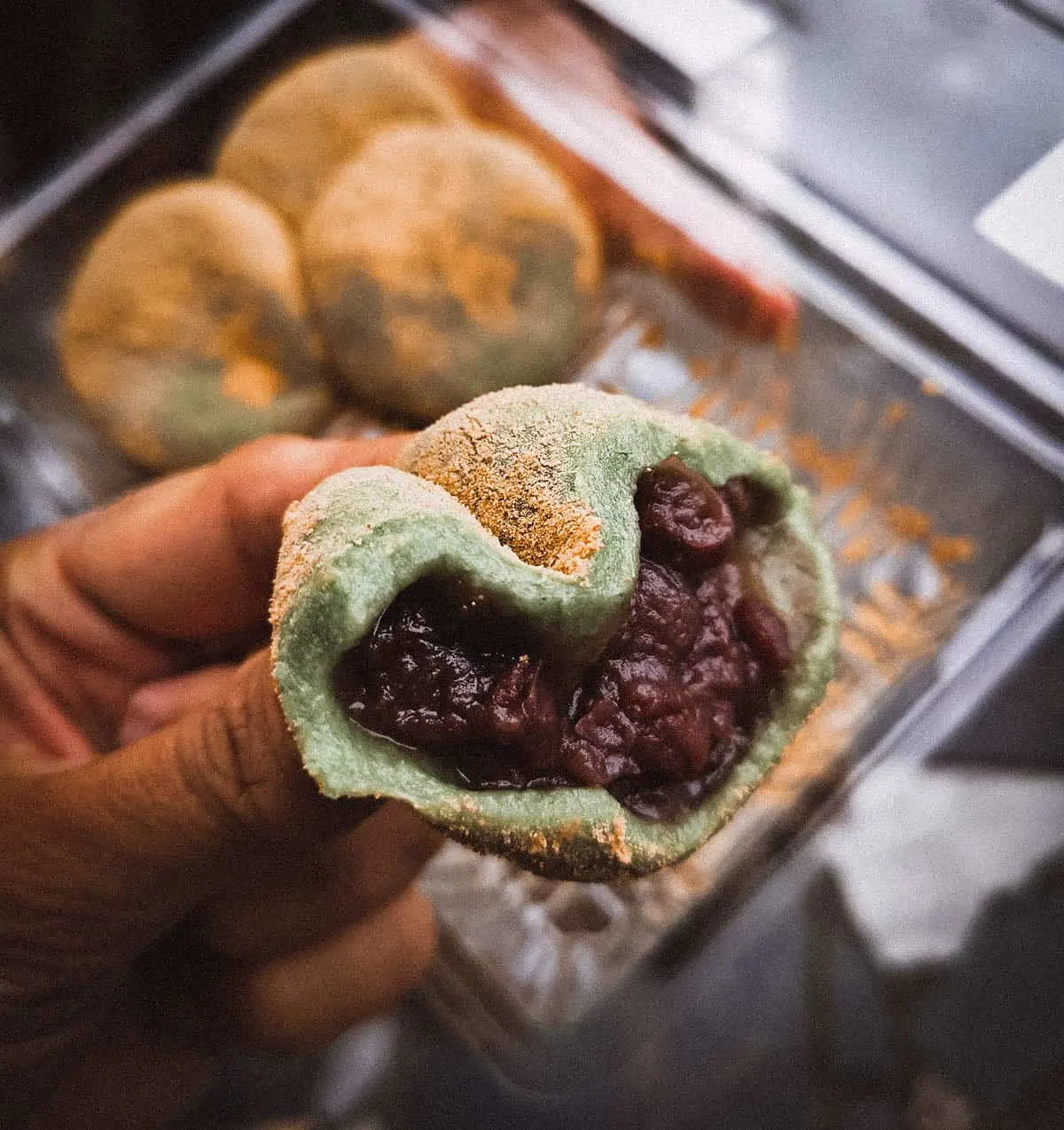
Nakatanidou is located along the main road, between Nara station and the main park area. You can refer to the location map below to see where it is. Nakatanidou is popular so you can always expect a crowd, but no worries, the queue moves quickly.
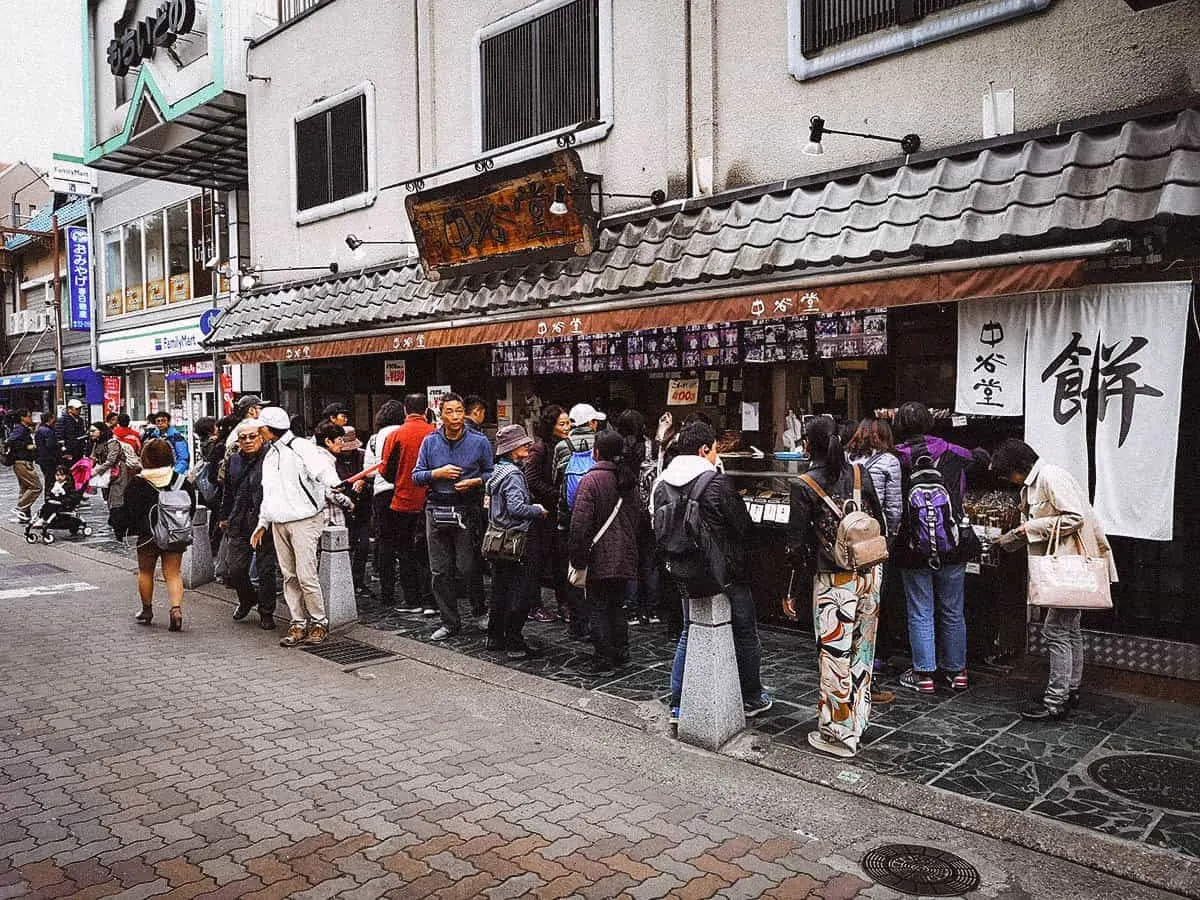
2. Kura Izakaya
An izakaya is a type of informal Japanese pub. It’s a casual place where you can have a few drinks over small plates of bar food. You can think of it as the Japanese equivalent to Irish pubs or Spanish tapas bars.
We’ve been to a few izakayas in Japan, but Kura is one of the best we’ve been to so far. Tsutomu agrees with us too. They serve many interesting dishes, the likes of which we haven’t had anywhere else in Japan. If you’re looking for a place to unwind and enjoy a few beers after exploring Nara, then we highly recommend Kura.
Check out my post on Kura Izakaya for more pictures and information.
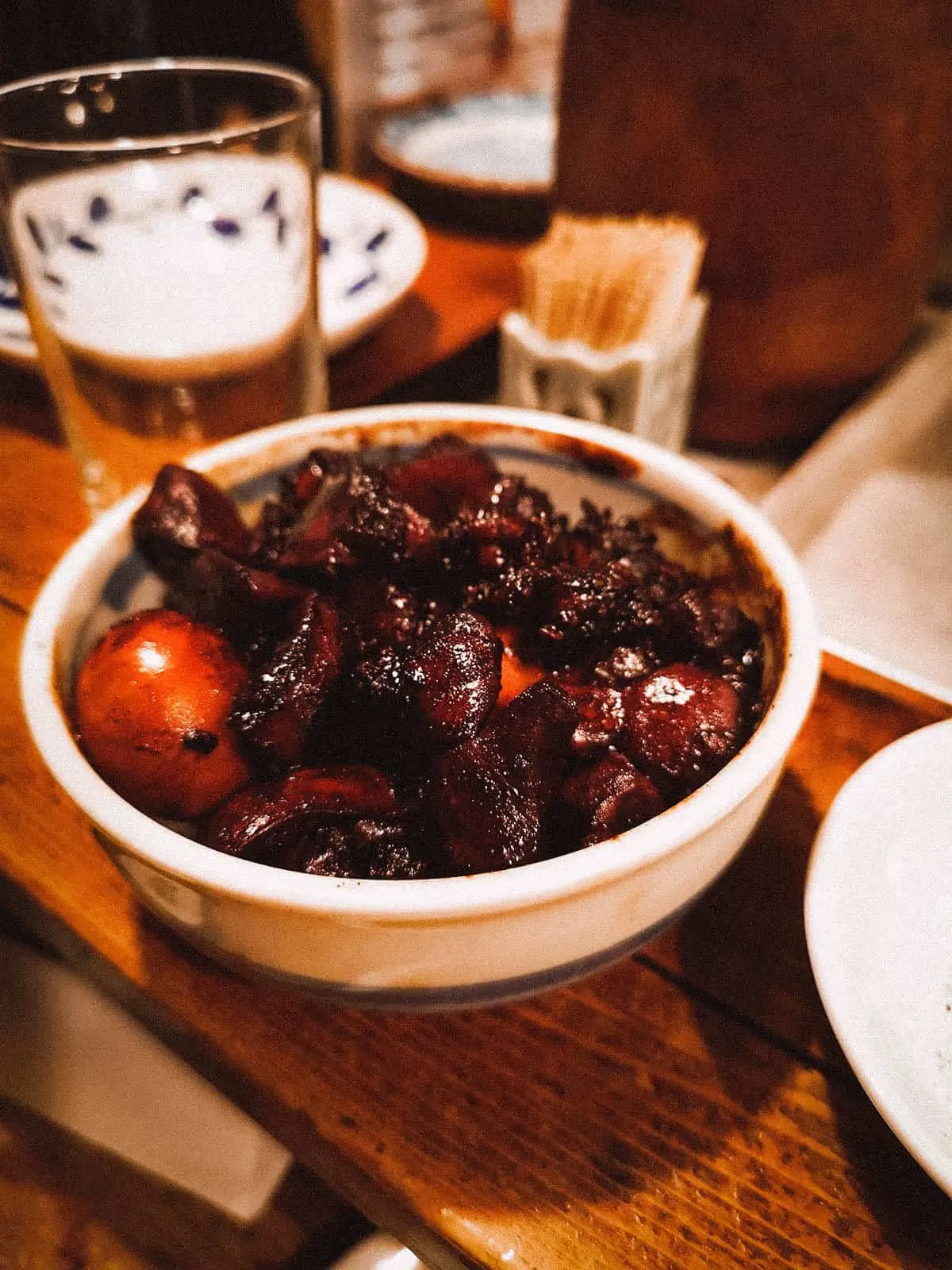
Kura is located in Naramachi, between Nara station and the main park area. It’s in a convenient spot but it can be a little hard to find, so you can refer to this map to see exactly where it is. It’s in the building pictured below, through the sliding doors with the Japanese kanji characters.
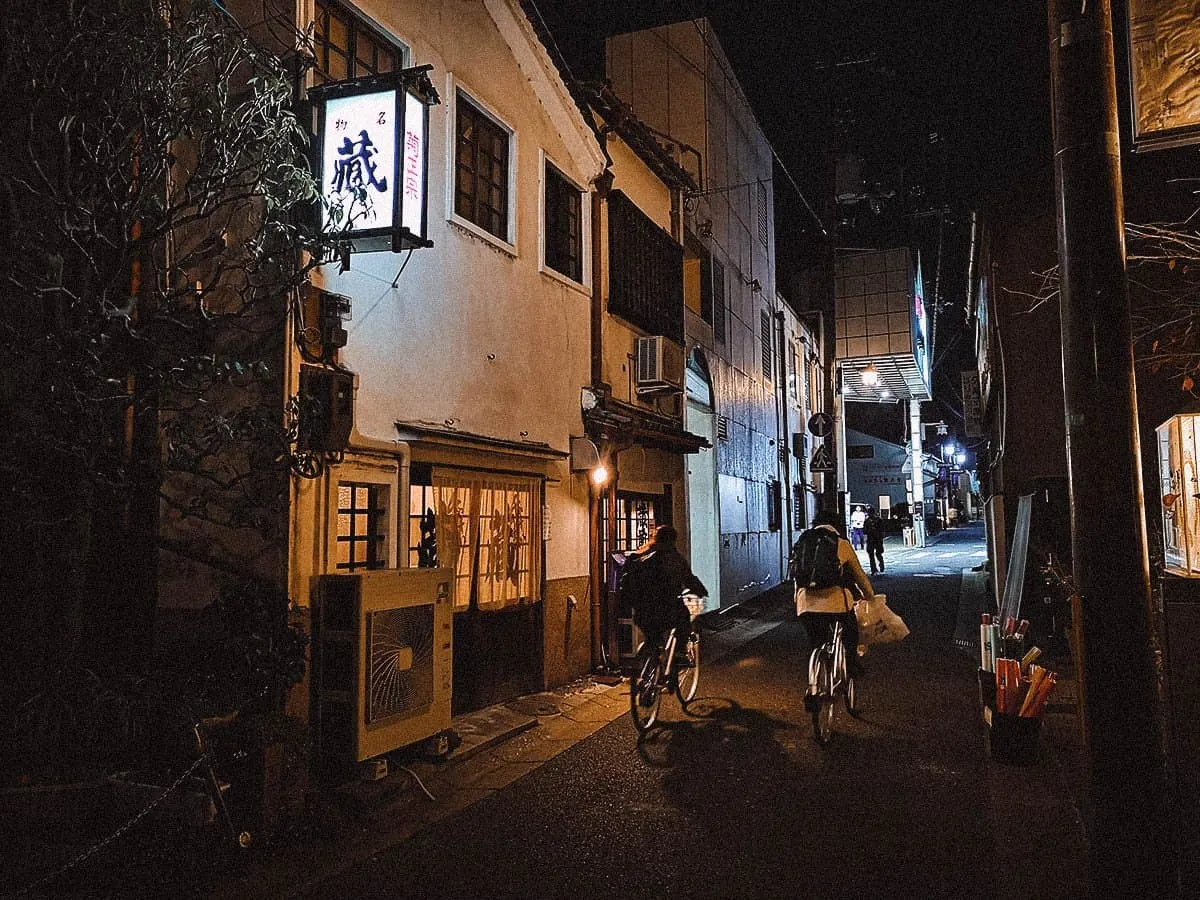
POINTS OF INTEREST IN NARA
To help you get your bearings, I’ve created this map so you get a better sense of where everything is. All of the places recommended in this guide are pinned on this map. Click on the link for an live version of the map.
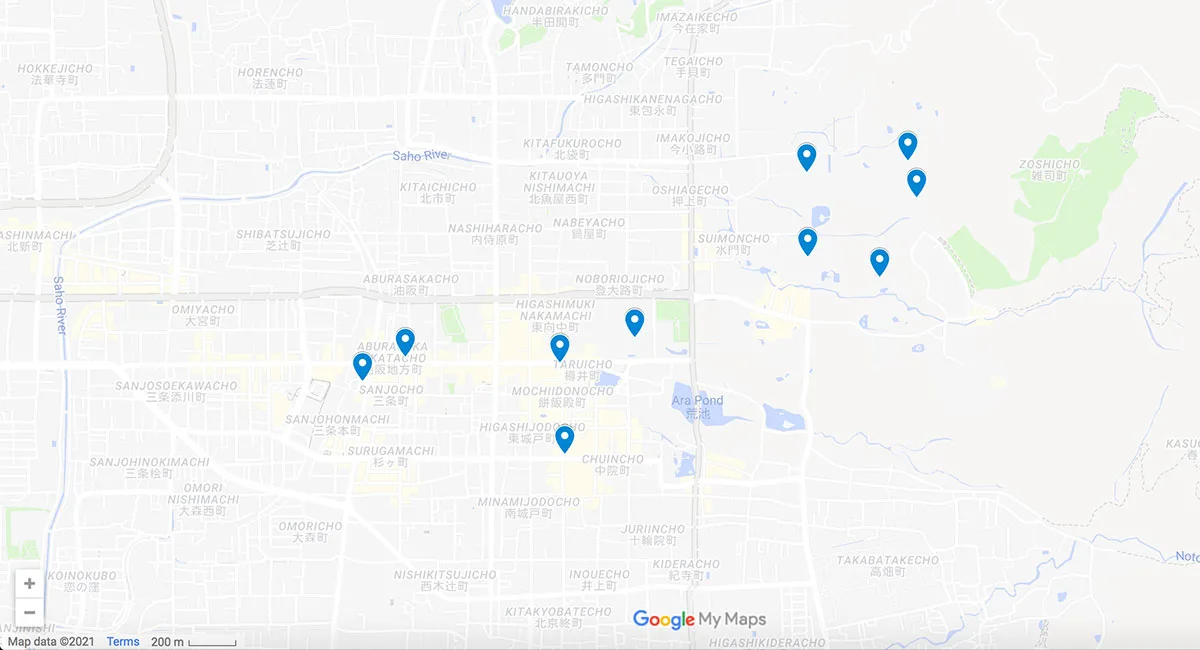
SAMPLE 1-DAY NARA ITINERARY
There’s a lot to see in Nara but this guide focuses on the most important attractions within the main park area. Here’s a suggested itinerary.
- 9AM – Arrive by train in Nara.
- 9:15-9:45AM – Get fitted and styled for a kimono.
- 10-10:30AM – Have kusa mochi at Nakatanidou. Watch Mitsuo Nakatani make mochi.
- 10:45-11:30AM – Take a few pictures at Kofuku-ji Temple.
- 11:45AM-1PM – Take a stroll and have matcha at Isui-en Garden.
- 1:15-2PM – Feed sika deer in front of Nandaimon Gate. Eat street food.
- 2:15-4PM – Explore Todai-ji Temple – Daibutsuden, Nigatsu-do Hall, Hokke-do Hall, and Todai-ji Museum.
- 4:30-6PM – Explore Kasuga-taisha Shrine.
- 6:30PM – Return the kimono.
- 7PM-onwards – Unwind with food and drinks at Kura Izakaya (reservations recommended).
NARA TRAVEL TIPS
1. Plan your Trip with Sygic Travel
If you enjoy planning your own trips, then you may find Sygic Travel useful. I’ve been using this free travel app to create itineraries for many years now. It allows me to pin all points of interest on a map – things like hotels, restaurants, and tourist attractions – then grouping them by day based on location. It’s available for free on iOS and Android.
2. Stay Connected
We never go anywhere without renting a pocket wifi device first. It’s essential for travel, especially in a country like Japan. It helps us bridge the language barrier and navigate through its highly efficient but often confusing railway system. Having access to Hyperdia alone justifies the cost.
Personally, we prefer renting pocket wifi devices with unlimited data because we find them to be simpler and more reliable, but a sim card is fine too. Regardless of your preference, you can arrange for them through Klook (4G pocket wifi | 4G sim card) or Get Your Guide.
3. Bookmark Hyperdia or Get the App on your Mobile Device
I can’t stress enough how helpful Hyperdia is. Japan’s train system is efficient and extensive but also confusing, especially with the language barrier. If you’ll be riding the trains a lot, and I’m pretty sure you will, then this website/app will make it so much easier. Without it, you may never get out of Japan’s subway system alive. Just kidding, but it is a lifesaver for foreign commuters in Japan.
WEBSITE: hyperdia.com
4. Check for Nara Travel Deals
There are many websites that offer discount passes to tours and services. Among the sites I use the most are Klook and Get Your Guide. They offer deals in many cities around the world, including Nara. If you’re on the hunt for travel deals or simply looking for interesting things to do in Nara, then I suggest checking out Klook and Get Your Guide. It’s always fun to see what’s available even if I don’t wind up buying anything.
5. Don’t Taunt the Deer
I didn’t intend to taunt a deer, but that’s exactly what I wound up doing when it wouldn’t leave me alone. And it made sure to punish me for it.
As described in the THINGS TO DO section of this guide, these sika deer can get aggressive when it comes to food. I was feeding this young buck when it started getting aggressive with my last cracker. I wanted to give it to another deer but this one was having none of it. When it wouldn’t back off, I struck this Bruce Lee pose hopefully to scare it away. Big mistake.
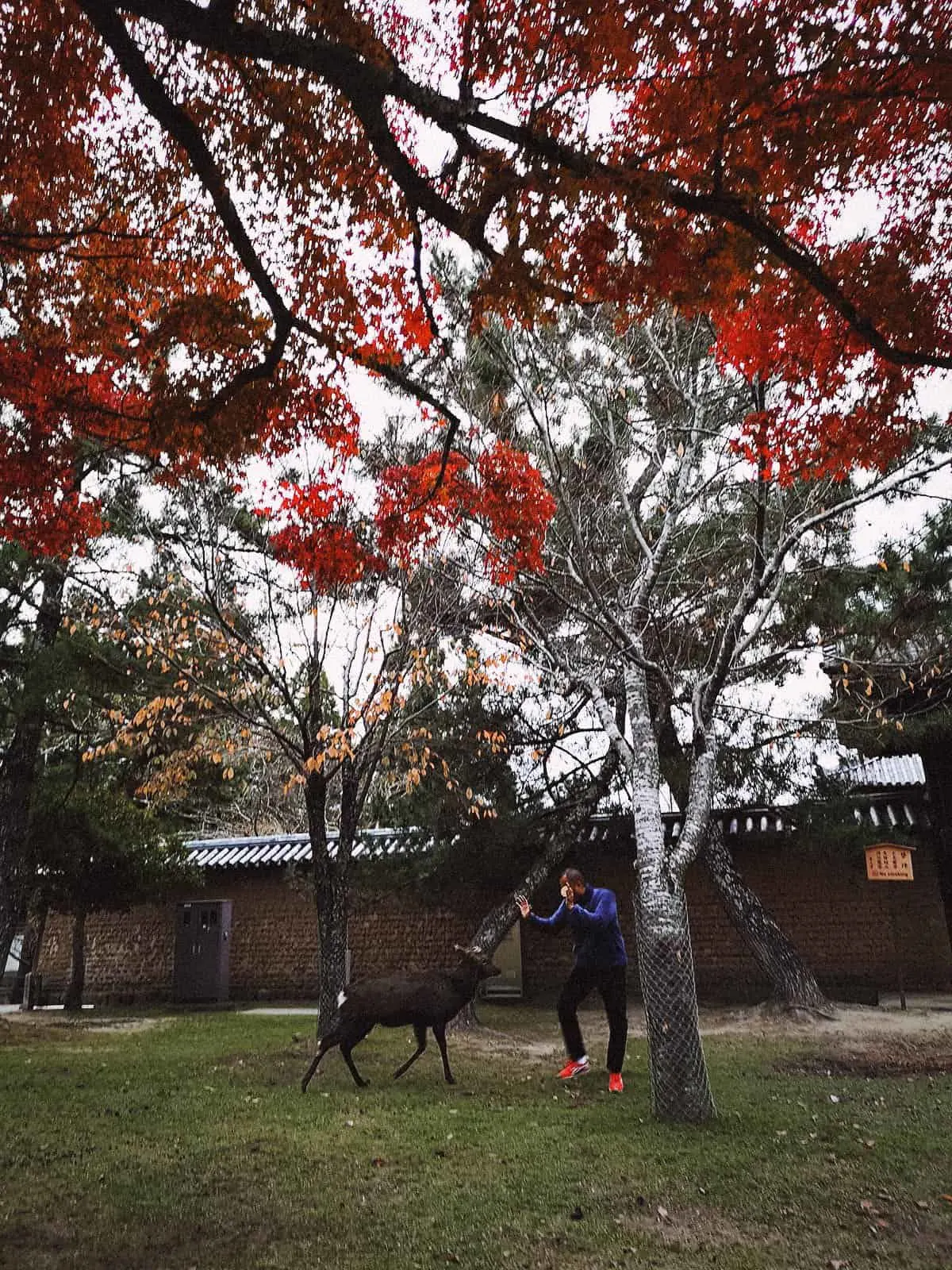
Instead of respecting my authority, the dude got pissed and charged me! It rammed me in the ass and launched me a couple of inches off the ground. I wasn’t hurt but it did serve as a reminder that these deer aren’t domesticated animals and not to be messed with.
When you’re in Nara, remember that you’re on their turf so it’s best to tread lightly. Treat them with the utmost respect and leave the kung fu for another species, preferably one without sharp antlers on its head.
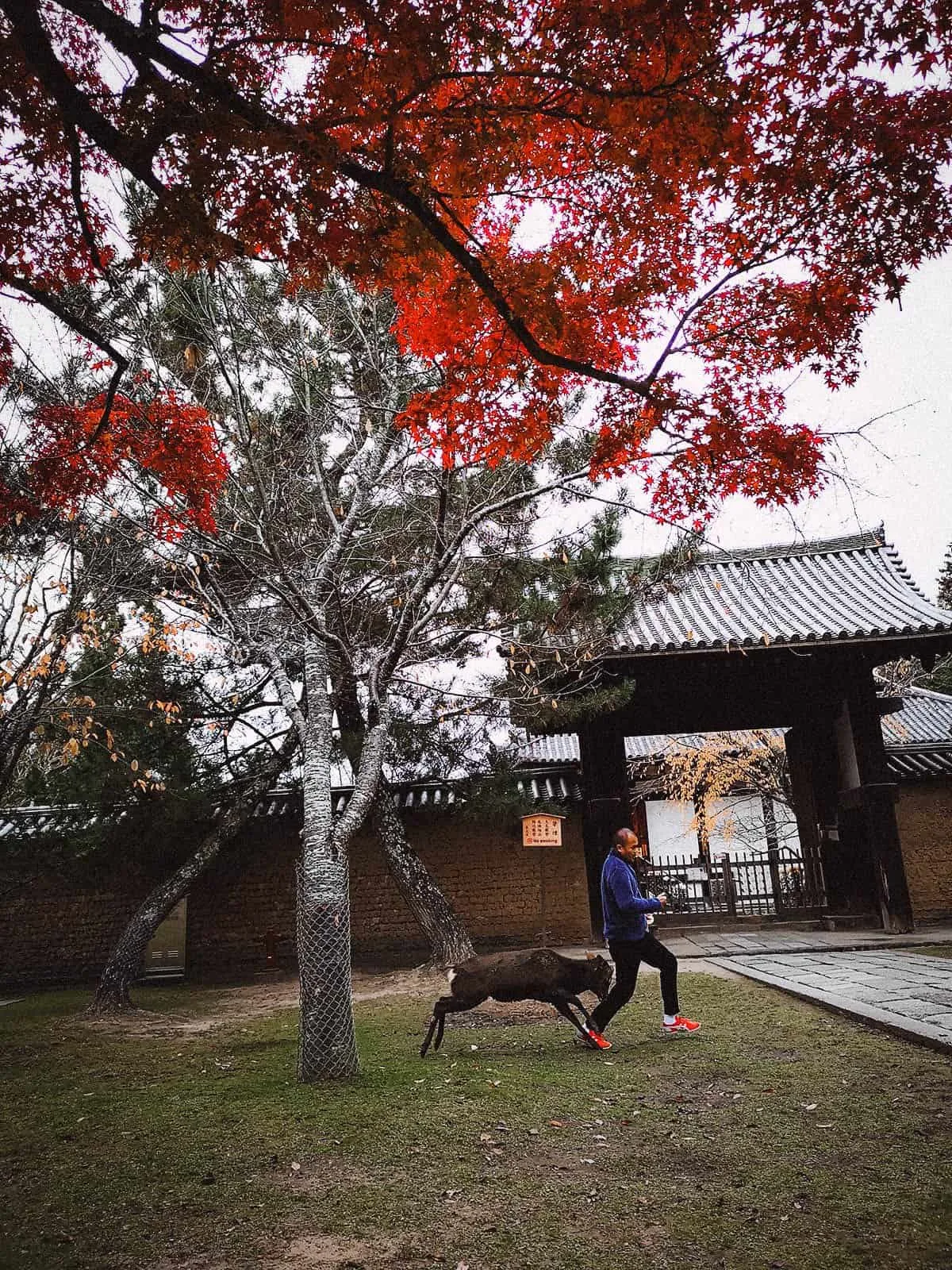
6. Get Travel Insurance
To be honest, travel insurance isn’t something we get all the time. It depends on where we’re going and what we have planned. If all we’ll be doing is visiting a city like Osaka to stuff our faces with sushi for a few days, then we probably won’t get it. But if we go to Yosemite to free solo El Capital like Alex Honnold, then I’ll definitely pick up a policy.
We buy travel insurance from SafetyWing or Heymondo. They’re popular travel insurance providers used by many digital nomads. Click on the links to get a free quote from SafetyWing or Heymondo. Get 5% off on Heymondo if you pick up a policy using our link.
7. Bring the Right Power Adapter
Japan has Type A or Type B electrical outlets so be sure to bring the right power adapters for your devices. Electrical voltage is 100V and the standard frequency is 50/60Hz.
8. Learn Basic Japanese Etiquette
Did you know that tipping may be considered an insult in Japan? There are unspoken rules of etiquette in this country, many of which may be different from yours, so it’s a good idea to familiarize yourself with the basics. Before your trip, I suggest going over this helpful overview on Japanese etiquette for tourists.
Have Fun!
I’m hardly an expert on Nara but I do hope you find this post helpful. I’m only sharing some of the things I learned from our trip. If you have any suggestions, then please feel free to let us know in the comment section below.
Thanks for stopping by and have a great time feeding the deer in Nara!
Disclosure
Some of the links in this Nara travel guide are affiliate links. We’ll earn a small commission if you make a booking at no extra cost to you. We only recommend products and services that we use ourselves and firmly believe in. We really appreciate your support as this helps us make more of these free travel guides. Thank you!


claire
Saturday 20th of April 2019
hi! if we will be staying in osaka and will just take a day tour to kyoto and then another day tour to narra, what pass will you suggest we get? and what modes of transportation did you use around these attractions around narra and kyoto? thank you. will really appreciate your reply because this will be our first time in japan. im really clueless on the different trains they have.
JB & Renée
Saturday 27th of April 2019
Hi Claire, by "day tour", you mean on your own right? Not with an organized tour? For what you intend to do, I think an ICOCA IC Card may be best. You can use it to get around in and between Osaka, Kyoto, and Nara. You can refer to the HOW TO GET AROUND SECTION of this post for more details. Hope that helps and enjoy Japan! :)
Brit on the Move
Thursday 21st of February 2019
Hi there, Japan is on my 2020 list but who knew you could feed the Sika Deer, this is totally new for me - I had no clue:) I've booked marked this page and will be referencing it for things to do! Thanks, Nikki
JB & Renée
Friday 22nd of February 2019
Happy to help Nikki! Enjoy Japan. :)